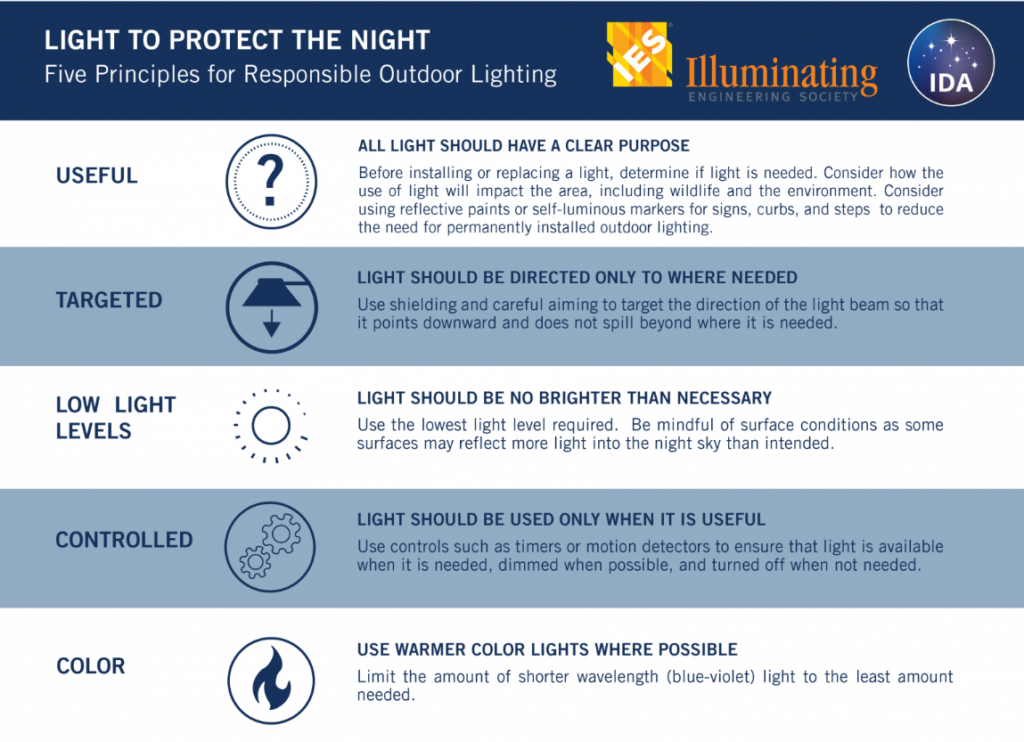Breadcrumb Navigation
- Lighting Insights
- DLC LUNA: Energy Savings Meets Reduced Light Pollution
DLC LUNA: Energy Savings Meets Reduced Light Pollution
In the dark about DLC’s new certification for outdoor lighting at night? Read on and we’ll shed some light.

The Design Light Consortium’s newest initiative brings dark skies-friendly outdoor lighting one step closer to mainstream. Happily, Cree Lighting has a deep bench of products that make the cut right out of the box.
In 1988, two astronomers concerned with the fast-disappearing dark night skies above the United States founded the International Dark Skies Association (IDA). The IDA mission: "to preserve and protect the nighttime environment and our heritage of dark skies through quality outdoor lighting." Even as the problem of light pollution has worsened over the last 35 years, the IDA’s agenda has slowly but surely gained legitimacy with the public and with policymakers. Still, preserving dark skies has generally been embraced only by likeminded customers willing to incorporate these practices into their lighting designs and budgets.
That may change now, and rapidly: the Design Light Consortium (DLC) is throwing its weight behind the IDA’s recommendations to preserve and restore the nighttime sky with the Q1 2022 introduction of the LUNA Technical Requirements V1.0. The DLC’s SSL Qualified Products List (QPL) is already the go-to reference for determining the eligibility of LED luminaires for energy rebates. Even when rebates aren’t available, the QPL has become the default means of quickly finding high-efficiency commercial LED lighting products. As of this writing, the QPL for solid state lighting is in its fifth version: SSL Technical Requirements Version 5.1.
Meanwhile, public awareness and concern over light pollution continues to grow, along with the number of lighting ordinances designed to curb it. This growing movement, as well as the continued demand for energy-efficient products, leads the DLC to predict robust participation in the LUNA qualification by the end of 2022.
Five Principles of Responsible Outdoor Lighting

How Does the DLC Position LUNA Versus the SSL QPL?
The DCL describes the LUNA Technical Requirements V1.0 as complementing existing DLC requirements for outdoor lighting. LUNA-qualified products must first meet the existing DLC SSL V5.1 requirements for lighting efficiency and quality, then must meet additional criteria that help limit light pollution such as sky glow and light trespass. Additionally, the LUNA requirement calls for the use of warm white light – 2200K to 3000K CCT.
In the DLC’s own words:
LUNA V. 1.0 seeks to establish performance specs and best practices for outdoor lighting with the following goals:
1. Minimize lighting energy use. In addition to meeting the efficacy thresholds of the DLC’s SSL V5.1 Technical Requirements, LUNA qualified products must meet additional dimming, control, and shielding requirements to ensure efficient use of lighting energy. These thresholds will help efficiency programs meet or exceed their energy savings goals and end users reduce operational costs.
2. Minimize light pollution. The LUNA program introduces requirements for light distribution, correlated color temperature (CCT), and dimming controls that ensure less light is scattered into the atmosphere, resulting in reduction of light trespass and sky glow, and darker skies for stargazers, astronomers, and wildlife.
3. Provide appropriate visibility for people. The LUNA program incorporates all SSL V5.1 spectral quality requirements, BUG reporting requirements, and additional spectral power distribution and intensity distribution reporting requirements, enabling lighting installations to meet recommended practices and voluntary guidelines for dark-sky best practices.
One Requirement to Rule Them All
Rather than introduce a standard that competes with or conflicts with existing guidelines issued by other organizations, the DLC constructed the LUNA requirements so that qualifying luminaires will also comply with the IDA-IES Model Lighting Ordinance (MLO), a legislative template intended to save communities from having to reinvent the wheel when drawing up dark-sky ordinances. The MLO was jointly developed by the International Dark Skies Association (IDA) and the Illuminating Engineering Society (IES) in 2011 and was updated in 2020.
LUNA qualification satisfies other third parties as well. LUNA products can be used to meet the light pollution and trespass requirements for LEED certification, and LUNA products of 2700K to 3000K CCT can be used to meet the light pollution and trespass requirements for 2021 WELL certification.
LUNA and Controls
LUNA products must be dimming capable – in particular, continuously dimmable to 20% or less of maximum light output. The DLC’s reasoning is that whenever an outdoor luminaire is dimmed, by whatever means, sky glow is reduced. This is true even for zero-uplight luminaires, since dimming lessens reflections from the ground and other surfaces. Dimming can also mitigate light trespass, overlighting and wasted energy.
While the ability to dim the luminaire is a must, a standard control receptacle is not – at least, not yet. But it is likely coming. The SSL QPL already provides details about a product’s controllability and communication, and because dark-sky ordinances are proliferating rapidly throughout the world, the DLC further reasons that installing a controllable product with a standardized control receptacle reduces the risk of obsolescence.
In Scope, Out of Scope
For various reasons, several categories of outdoor products are currently excluded from the LUNA requirement:
- Floodlights, replacement lamps and retrofit kits are excluded because these products are highly dependent on project design and installation, and efforts to mitigate light pollution must be addressed on a project-by-project basis.
- Luminaires for parking garages, stairwells/passageways and tunnels are not included because uplight is typically blocked and contained by the structure where the lighting is installed.
- Non-white light is out of scope for LUNA’s initial release because standardized metrics are still in development. (Notably, this would include Cree Lighting’s Turtle-Friendly Luminaires, which produce amber light below 2200K.)
Because meeting the LUNA requirements will decrease the efficacy of some products (such as bollards), the SSL QPL qualifying thresholds for these types of luminaires are being adjusted to compensate.
What It All Means for the Market
The DLC expects LUNA Technical Requirements V1.0 to drive certain changes to lighting products and specifications. We’ll likely see more decorative roadway and area luminaires with less uplight to meet the initial LUNA requirement of U2 or lower. Based on LUNA spectral and efficacy requirements, we can also expect to see more outdoor luminaires with a CCT of 2200K to 2700K at 105 lumens per watt or higher.
Because LUNA offers a compensatory allowance for the drop in efficacy created by shielding, more shielded products are expected to make the QPL. And the DLC predicts there will be more publicly shared luminaire spectral data and more efforts to standardize outdoor chromaticity specifications for white and amber spectra.
For now, according to the DLC, there’s at least one version of most QPL roadway and area luminaires with an uplight rating of U0 or U1 at 3000K CCT. LUNA qualification is expected to present the greatest challenge to decorative products and bollards, even with the efficacy allowance.
Cree Lighting Products Are Part of the Solution
You probably won’t be surprised to learn that Cree Lighting has been providing products that meet the LUNA spec for years, such as the RSW Series Streetlight introduced in 2016. In fact, most Cree Lighting outdoor product lines for street, roadway and area lighting include a CCT option of 3000K or lower that meet LUNA requirements. Check out our LED bollard lights and pathway options to see how Cree Lighting can brighten up your walkways.
Duane Henderson, Cree Lighting’s Lead Lighting Educator, notes that LUNA does not replace the value of lighting design, but complements it.
Henderson states, “While LUNA gets more products installed to help reduce light pollution, it doesn’t replace the value of lighting design. Good lighting design validates minimum illumination requirements that can be maintained over time, values optical control, reduces waste and minimizes risk. The lighting design process should include a realistic defined application or system life for the luminaire ̶ 50,000 hours is common for non-commodity products, as well as a product-specific lumen depreciation value at that defined application life. When this value is incorporated into a lighting design, it will give preference to products that lose less light over time, meaning applications are not being dramatically overlit on night one, and needlessly creating significantly more light pollution early in their application lives.”
Finally, Henderson believes the move to more responsible outdoor lighting is a lasting change. “As industry stakeholders, including end users, are exposed to the conversation regarding the negative effects of light pollution, everyone wants to do the right thing. We’ve been well positioned here at Cree Lighting with many products that can help for quite some time. It’s exciting because as this shift continues to occur, we’ll be assisting our customers in achieving economic and energy goals, while influencing the night sky we all share in a positive way.”

